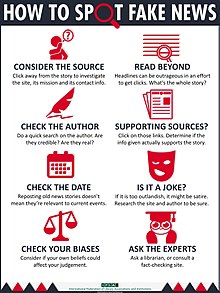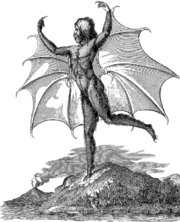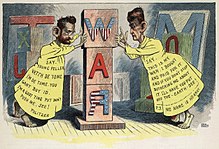Fake news
Fake news is a neologism[1][12] often used to refer to fabricated news.[1] This type of news, found in traditional news, social media[1] or fake news websites, has no basis in fact, but is presented as being factually accurate.[13] Michael Radutzky, a producer of CBS 60 Minutes, said his show considers fake news to be "stories that are provably false, have enormous traction [popular appeal] in the culture, and are consumed by millions of people". These stories can not only be found in politics, but also in areas like vaccination, stock values and nutrition.[14] He did not include fake news that is "invoked by politicians against the media for stories that they don't like or for comments that they don't like". Guy Campanile, also a 60 Minutes producer said, "What we are talking about are stories that are fabricated out of thin air. By most measures, deliberately, and by any definition, that's a lie."[15] The intention and purpose behind fake news is important. In some cases, what appears to be fake news may in fact be news satire, which uses exaggeration and introduces non-factual elements that are intended to amuse or make a point, rather than to deceive. Propaganda can also be fake news.[4]
Claire Wardle of First Draft News identifies seven types of fake news:[16]
- satire or parody ("no intention to cause harm but has potential to fool")
- false connection ("when headlines, visuals or captions don't support the content")
- misleading content ("misleading use of information to frame an issue or an individual")
- false context ("when genuine content is shared with false contextual information")
- imposter content ("when genuine sources are impersonated" with false, made-up sources)
- manipulated content ("when genuine information or imagery is manipulated to deceive", as with a "doctored" photo)
- fabricated content ("new content is 100% false, designed to deceive and do harm")
Some, most notably United States President Donald Trump, have broadened the meaning of "fake news" to include accurate news they don't like.[22][23] Trump confirmed this interpretation of fake news as negative news about himself in a tweet on May 9, 2018.[24][25][26][27]
Identifying
Infographic How to spot fake news published by the International Federation of Library Associations and Institutions
- Consider the source (to understand its mission and purpose)
- Read beyond the headline (to understand the whole story)
- Check the authors (to see if they are real and credible)
- Assess the supporting sources (to ensure they support the claims)
- Check the date of publication (to see if the story is relevant and up to date)
- Ask if it is a joke (to determine if it is meant to be satire)
- Review your own biases (to see if they are affecting your judgement)
- Ask experts (to get confirmation from independent people with knowledge).
Beginning in the 2017 school year, children in Taiwan study a new curriculum designed to teach critical reading of propaganda and the evaluation of sources. Called "media literacy", the course provides training in journalism in the new information society.[32]
Historical examples
Ancient
Roman politician and general Mark Antony killed himself because of misinformation.[33]
In the 13th century BC, Rameses the Great spread lies and propaganda portraying the Battle of Kadesh as a stunning victory for the Egyptians; he depicted scenes of himself smiting his foes during the battle on the walls of nearly all his temples. The treaty between the Egyptians and the Hittites, however, reveals that the battle was actually a stalemate.[34]
During the first century BC, Octavian ran a campaign of misinformation against his rival Mark Antony, portraying him as a drunkard, a womanizer, and a mere puppet of the Egyptian queen Cleopatra VII.[35] He published a document purporting to be Marc Antony's will, which claimed that Marc Antony, upon his death, wished to be entombed in the mausoleum of the Ptolemaic pharaohs. Although the document may have been forged, it invoked outrage from the Roman populace.[36] Marc Antony ultimately killed himself after his defeat in the Battle of Actium upon hearing false rumors propagated by Cleopatra herself claiming that she had committed suicide.[33]
During the second and third centuries AD, false rumors were spread about Christians claiming that they engaged in ritual cannibalism and incest.[37][38] In the late third century AD, the Christian apologist Lactantius invented and exaggerated stories about pagans engaging in acts of immorality and cruelty,[39] while the anti-Christian writer Porphyry invented similar stories about Christians.[40]
Medieval
In 1475, a fake news story in Trent claimed that the Jewish community had murdered a two-and-a-half-year-old Christian infant named Simonino.[41] The story resulted in all the Jews in the city being arrested and tortured; fifteen of them were burned at the stake.[41] Pope Sixtus IV himself attempted to stamp out the story, but, by that point, it had already spread beyond anyone's control.[41] Stories of this kind were known as "blood libel"; they claimed that Jews purposely killed Christians, especially Christian children, and used their blood for religious or ritual purposes.[42]Early modern period
After the invention of the printing press in 1439, publications became widespread but there was no standard of journalistic ethics to follow. By the 17th century, historians began the practice of citing their sources in footnotes. In 1610 when Galileo went on trial, the demand for verifiable news increased.[41]During the 18th century publishers of fake news were fined and banned in the Netherlands; one man, Gerard Lodewijk van der Macht, was banned four times by Dutch authorities—and four times he moved and restarted his press.[43] In the American colonies, Benjamin Franklin wrote fake news about murderous "scalping" Indians working with King George III in an effort to sway public opinion in favor of the American Revolution.[41]
Canards, the successors of the 16th century pasquinade, were sold in Paris on the street for two centuries, starting in the 17th century. In 1793, Marie Antoinette was executed in part because of popular hatred engendered by a canard on which her face had been printed.[44]
During the era of slave-owning in the United States, supporters of slavery propagated fake news stories about African Americans, whom white people considered to have lower status.[45] Violence occurred in reaction to the spread of some fake news events. In one instance, stories of African Americans spontaneously turning white spread through the south and struck fear into the hearts of many people.[46]
Rumors and anxieties about slave rebellions were common in Virginia from the beginning of the colonial period, despite the only major uprising occurring in the 19th century. One particular instance of fake news regarding revolts occurred in 1730. The serving governor of Virginia at the time, Governor William Gooch, reported that a slave rebellion had occurred but was effectively put down – although this never happened. After Gooch discovered the falsehood, he ordered slaves found off plantations to be punished, tortured, and made prisoners.[47]
19th century
A "lunar animal" said to have been discovered by John Herschel on the Moon
In the late 19th century, Joseph Pulitzer and other yellow journalism publishers goaded the United States into the Spanish–American War, which was precipitated when the U.S.S. Maine exploded in the harbor of Havana, Cuba.[49]
Joseph Pulitzer and William Randolph Hearst caricatured as they urged the U.S. into the Spanish–American War.
20th century
During the First World War, an example of anti-German atrocity propaganda was that of an alleged "German Corpse Factory" in which the German battlefield dead were rendered down for fats used to make nitroglycerine, candles, lubricants, human soap, and boot dubbing. Unfounded rumors regarding such a factory circulated in the Allied press starting in 1915, and by 1917 the English-language publication North China Daily News presented these allegations as true at a time when Britain was trying to convince China to join the Allied war effort; this was based on new, allegedly true stories from The Times and The Daily Mail that turned out to be forgeries. These false allegations became known as such after the war, and in the Second World War Joseph Goebbels used the story in order to deny the ongoing massacre of Jews as British propaganda. According to Joachim Neander and Randal Marlin, the story also "encouraged later disbelief" when reports about the Holocaust surfaced after the liberation of Auschwitz and Dachau concentration camps.[50] After Hitler and the Nazi Party rose to power in Germany in 1933, they established the Reich Ministry of Public Enlightenment and Propaganda under the control of Propaganda Minister Joseph Goebbels.[51] The Nazis used both print and broadcast journalism to promote their agendas, either by obtaining ownership of those media or exerting political influence.[52] Throughout World War II, both the Axis and the Allies employed fake news in the form of propaganda to persuade publics at home and in enemy countries.[53][54] The British Political Warfare Executive used radio broadcasts and distributed leaflets to discourage German troops.[51]The Carnegie Endowment for International Peace has published that The New York Times printed fake news "depicting Russia as a socialist paradise."[55] During 1932–1933, The New York Times published numerous articles by its Moscow bureau chief, Walter Duranty, who won a Pulitzer prize for a series of reports about the Soviet Union.
21st century
In the 21st century, the impact of fake news became widespread,[2] as well as the usage of the term. The opening of the internet to the people in the 90s was a movement meant to allow them access to information. Over time, the internet has grown to unimaginable heights with tons of information coming in all the time which allows the internet to be a host for plenty of unwanted, untruthful and misleading information that can be made by anyone.[56] Besides referring to made-up stories designed to deceive readers into clicking on links, maximizing traffic and profit, the term has also referred to satirical news, whose purpose is not to mislead but rather to inform viewers and share humorous commentary about real news and the mainstream media.[57][58] United States examples of satire (as opposed to fake news) include the television show Saturday Night Live's Weekend Update, The Daily Show, The Colbert Report, The Late Show with Stephen Colbert and The Onion newspaper.[59][60][61]21st century fake news is often intended to increase the financial profits of the news outlet. In an interview with NPR, Jestin Coler, former CEO of the fake media conglomerate Disinfomedia, said who writes fake news articles, who funds these articles, and why fake news creators create and distribute false information. Coler, who has since left his role as a fake news creator, said that his company employed 20 to 25 writers at a time and made $10,000 to $30,000 monthly from advertisements. Coler began his career in journalism as a magazine salesman before working as a freelance writer. He said he entered the fake news industry to prove to himself and others just how rapidly fake news can spread.[62] Disinfomedia is not the only outlet responsible for the distribution of fake news; Facebook users play a major role in feeding into fake news stories by making sensationalized stories "trend", according to BuzzFeed media editor Craig Silverman, and the individuals behind Google AdSense basically fund fake news websites and their content.[63] Mark Zuckerberg, CEO of Facebook, said, "I think the idea that fake news on Facebook influenced the election in any way, I think is a pretty crazy idea", and then a few days later he blogged that Facebook was looking for ways to flag fake news stories.[64]
Many online pro-Trump fake news stories are being sourced out of a small city in Macedonia, where approximately seven different fake news organizations are employing hundreds of teenagers to rapidly produce and plagiarize sensationalist stories for different U.S. based companies and parties.[65]
One fake news writer, Paul Horner, was behind the widespread hoax that he was the graffiti artist Banksy and had been arrested;[66][67] that a man stopped a robbery in a diner by quoting Pulp Fiction;[68][69] and that he had an "enormous impact" on the 2016 U.S. presidential election, according to CBS News.[70] These stories consistently appeared in Google's top news search results, were shared widely on Facebook, were taken seriously, and shared by third parties such as Trump presidential campaign manager Corey Lewandowski, Eric Trump, ABC News, and the Fox News Channel.[71][72][73] Horner later claimed that his work during this period was intended "to make Trump's supporters look like idiots for sharing my stories".[74]
In a November 2016 interview with The Washington Post, Horner expressed regret for the role his fake news stories played in the election and surprise at how gullible people were in treating his stories as news.[68][75][76][77] In February 2017 Horner said, "I truly regret my comment about saying that I think Donald Trump is in the White House because of me. I know all I did was attack him and his supporters and got people not to vote for him. When I said that comment it was because I was confused how this evil got elected President and I thought maybe instead of hurting his campaign, maybe I had helped it. My intention was to get his supporters NOT to vote for him and I know for a fact that I accomplished that goal. The far right, a lot of the Bible thumpers and alt-right were going to vote him regardless, but I know I swayed so many that were on the fence."[78]
In December 2016, while speaking on Anderson Cooper 360, Horner said that all news is fake news and said CNN "spread misinformation", which was one month before Trump leveled the same criticism at that network.[79][80]
Horner spoke at the European Parliament in March, speaking about fake news and the importance of fact checking.[81] According to a 2017 BuzzFeed article, Horner stated that a story of his about a rape festival in India helped generate over $250,000 in donations to GiveIndia, a site that helps rape victims in India.[82][83][84] Horner said he dislikes being grouped with people who write fake news solely to be misleading. "They just write it just to write fake news, like there's no purpose, there's no satire, there's nothing clever. All the stories I wrote were to make Trump's supporters look like idiots for sharing my stories."[85] The Huffington Post called Horner a "Performance Artist".[86] Horner has been referred to as a "hoax artist" by outlets such as the Associated Press and the Chicago Tribune.[87]
Kim LaCapria of the fact checking website Snopes.com has stated that, in America, fake news is a bipartisan phenomenon, saying that "[t]here has always been a sincerely held yet erroneous belief misinformation is more red than blue in America, and that has never been true."[88] Jeff Green of Trade Desk agrees the phenomenon affects both sides. Green's company found that affluent and well-educated persons in their 40s and 50s are the primary consumers of fake news. He told Scott Pelley of 60 Minutes that this audience tends to live in an "echo chamber" and that these are the people who vote.[89]
In 2014, the Russian Government used disinformation via networks such as RT to create a counter-narrative after Russian-backed Ukrainian rebels shot down Malaysia Airlines Flight 17.[90] In 2016, NATO claimed it had seen a significant rise in Russian propaganda and fake news stories since the invasion of Crimea in 2014.[91] Fake news stories originating from Russian government officials were also circulated internationally by Reuters news agency and published in the most popular news websites in the United States.[92]
A 2018 study at Oxford University[93] found that Trump's supporters consumed the "largest volume of 'junk news' on Facebook and Twitter":




No comments:
Post a Comment